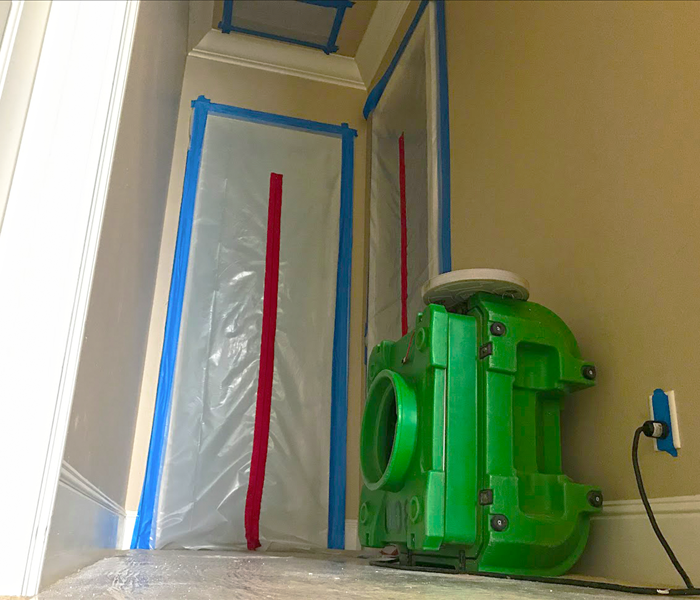How to Spot Mold Before It's Too Late
6/29/2023 (Permalink)
 A big mistake made by many DIY property owners and even some restoration companies is not properly containing an affected area before mold removal.
A big mistake made by many DIY property owners and even some restoration companies is not properly containing an affected area before mold removal.
Mold is a type of fungus that can grow in moist environments. It is even more commonly found in Florida homes and buildings due to the moist and humid conditions. Still, it is not always easy to identify a real mold issue without experience.
Here are some of the most common signs of mold growth:
- Visible mold: Mold can appear as black, green, or white fuzzy or slimy growths. It can also appear as discolored spots or stains on walls, ceilings, furniture, and other surfaces.
- Musty odor: Mold has a distinctive musty odor. If you notice a musty smell in your home or business, it could be a sign of mold growth.
- Water damage: Mold needs moisture to grow, so if you see water damage in your home or business, it's a good indication that mold may be present. Water damage can occur from a variety of sources, such as leaks from pipes, roofs, or appliances.
- High humidity: Mold can also grow in humid environments. If the humidity in your home or business is consistently high, it's a good idea to check for signs of mold growth.
If you see any of these signs of mold growth, it's important to take action immediately. The longer you wait, the further damage to your property is likely to occur. Properly removing mold is an extensive process that can get quite costly, which is why many property owners defer to their insurance companies to cover remediation costs.
Here are some steps you can take to remove mold from your home or business:
- Identify the source of moisture. Once you've found mold, the first step is to identify the source of moisture that's causing it to grow. This could be a leaky pipe, a roof leak, or even just condensation from high humidity. Once you've identified the source of moisture, you can take steps to fix it.
- Remove the mold. Once you've fixed the source of moisture, you can start to remove the mold. Before doing so, it is recommended to properly contain the affected are so that mold spores released do not travel to other unaffected areas. You can do this yourself if the affected area is non-porous and small. Many online sources will recommend bleach, however, be cautious in doing so as using bleach on certain species of mold can cause a reaction that makes the problem worse. Instead, use organic mold treatments for cleanup.
- Ventilate the area. Once you've removed the mold, it's important to ventilate the area to prevent it from growing back. Many recommendations simply involve opening windows and doors or using a fan. A more effective method of doing so is to use a HEPA-filtered air scrubber to filter the affected air of mold spores. This should be done while containment is intact as well.
- Dry the area. Once you've ventilated the area, it's important to dry it completely. This will help to prevent the mold from growing back. You can dry the area by using a dehumidifier or by running fans.
If you're not comfortable removing mold yourself, you can hire a professional mold remediation company. These companies have the experience and expertise to remove mold safely and effectively. They also have the proper equipment to get the job done. Reputable and responsible remediation companies will require a written protocol from a licensed assessor to understand the exact mold issue in your property including, species, areas of the property affected, spore counts in the air, and proper steps for remediating the specific species of mold.
By following these steps, you can remove mold from your home or business and prevent it from coming back.
Here are some additional tips for preventing mold growth:
- Fix any leaks or water damage as soon as possible.
- Increase ventilation in your home or business.
- Use dehumidifiers to control humidity levels.
- Clean and disinfect regularly.
- Store damp items in airtight containers.
- Inspect your home or business for mold growth regularly.
By following these tips, you can help to keep your home or business mold-free.





 24/7 Emergency Service
24/7 Emergency Service